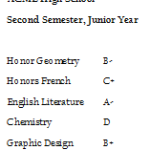Class Rank is important, it’s just not really important. It’s also complicated. For example, my children attend a High School that does not weight GPA’s. Nor, like some schools, does their school weight GPA solely for the calculation of class rank. If you are a student who takes a rigorous workload (Honors, AP or Baccalaureate courses), unweighted GPA’s can work against you. A student who chooses to take a less rigorous workload will likely find it easier to maintain a high GPA. But….
I read with concern that many selective holistic schools rank class rank as a “Very Important” consideration for admission, and that a large percentage (70, 80 or even 90%) of a selective school’s incoming Freshman were in the top 10% of the class. I became worried that my child with a high, but not perfect GPA, did not rank in the top 10% of their class, would be denied admission because they could not manage to maintain a 4.0 with their rigorous workload. I reminded myself that Academic Rigour is also usually often ranked as a “Very Important” consideration for admission, and that Admissions Officers will closely scrutinize and value my student’s workload. But it still bothered me.
Then I learned about the Common Data Set (CDS). It wasn’t until I read the CDS for some of the selective schools that I realized that while yes, a very high percentage of students were ranked highly, conversely a very low percentage of students reported their class rank! For example, one school listed the percentage of students in the top 10% of their class at nearly 75%, while just over 20% of students had reported their class rank. This taught me not only that class rank was less likely to hurt my children’s admission chances, but also, that they DID NOT NEED to report class rank if they felt it would work against them. On the other hand, your High School has chosen whether to include your class rank along with your transcript and other relevant information they submit to Colleges where you apply. If you are worried about your class rank, ask your High School Counselor about your school’s policy regarding submitting class rank.
This leads to another discussion about why some selective schools boast a holistic admission process but state that test scores, grades, class rank and the like are Very Important – I call it the College Admissions’ Publisher Rankings Anxiety. |






 Publisher Ranking Anxiety is my term for why Colleges that choose to take a holistic approach to admissions still focus on factors like test scores and GPA, because they are still worried how they will be ranked by publications such as the US News & World Report.
Publisher Ranking Anxiety is my term for why Colleges that choose to take a holistic approach to admissions still focus on factors like test scores and GPA, because they are still worried how they will be ranked by publications such as the US News & World Report.